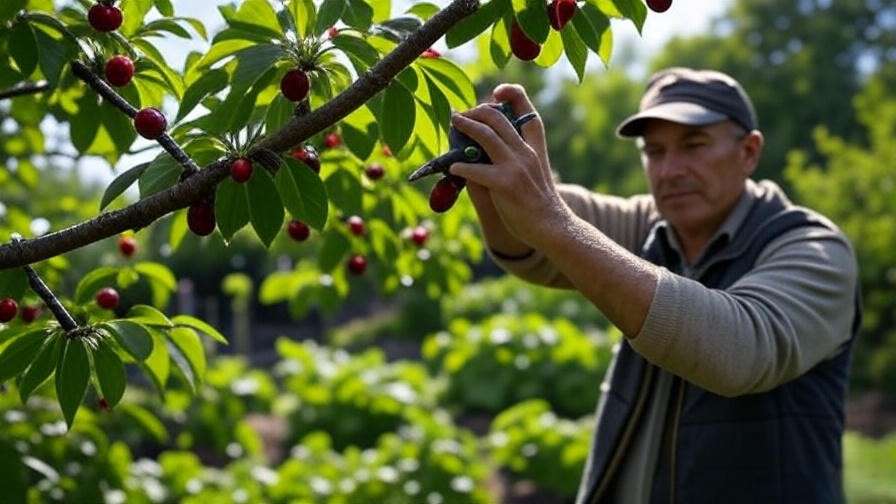Picture this: your backyard cherry tree, once bursting with vibrant blossoms, now looks tangled, with sparse fruit and wilting leaves. You’re not alone—many gardeners face this frustration, but the solution is simpler than you think. Pruning cherry trees is the key to unlocking their full potential, transforming them into thriving, fruit-heavy beauties. As a certified arborist with over 15 years of experience, I’ve seen firsthand how proper pruning can boost tree health, increase yields by up to 20%, and enhance your garden’s charm. In this comprehensive guide, we’ll walk you through every step of pruning cherry trees, from timing and tools to advanced techniques, ensuring your trees flourish for years to come. Ready to grow juicier cherries and a healthier tree? Let’s dive in! 🍒
H2: Understanding Cherry Tree Pruning: The Basics 🍒
H3: What is Pruning, and Why Do Cherry Trees Need It? 🌱
Pruning is the art and science of selectively removing branches to improve a tree’s structure, health, and productivity. For cherry trees, pruning is essential to promote robust growth, enhance fruit quality, and prevent disease. By removing dead or overcrowded branches, you allow better airflow and sunlight penetration, which are critical for cherry production. Without regular pruning, your tree may become dense, reducing fruit size and inviting pests or fungal infections like cherry leaf spot.
Why it matters: Proper pruning stimulates fruiting spurs, strengthens branches, and maintains an attractive shape. Research from university extension programs shows that well-pruned cherry trees can yield 15-20% more fruit than neglected ones. Whether you’re growing cherries for pies or simply love their springtime blooms, pruning is non-negotiable.
H3: Types of Cherry Trees and Their Pruning Needs 🌳
Cherry trees come in various types, each with unique pruning requirements:
- Sweet Cherry Trees (e.g., Bing, Rainier): These vigorous growers need light, annual pruning to maintain an open canopy and encourage large, sweet fruit.
- Sour Cherry Trees (e.g., Montmorency): More compact, they require moderate pruning to balance fruit production and vegetative growth.
- Dwarf and Semi-Dwarf Varieties: Ideal for small gardens, these need careful shaping to maximize space and yield.
- Ornamental Cherry Trees: Grown for blossoms, they require minimal pruning focused on aesthetics and health.
| Tree Type | Pruning Frequency | Key Focus |
|---|---|---|
| Sweet Cherry | Annual, light | Open canopy, fruit size |
| Sour Cherry | Annual, moderate | Balance growth and fruiting spurs |
| Dwarf/Semi-Dwarf | Annual, precise | Space efficiency, accessibility |
| Ornamental Cherry | Biennial, minimal | Shape, bloom enhancement |
Expert Tip: Always identify your cherry tree type before pruning to tailor your approach for optimal results.
H2: When to Prune Cherry Trees: Timing is Everything ⏰
H3: The Best Seasons for Pruning Cherry Trees 🌞❄️
Timing is critical when pruning cherry trees. The ideal period is late winter to early spring (dormant season, before buds swell), typically February to early April in USDA zones 5-9. During dormancy, the tree is less stressed, and wounds heal quickly, reducing disease risk. Light summer pruning (late June to July) is suitable for minor shaping or removing water sprouts, but heavy cuts should be avoided.
Why avoid fall pruning? Fall cuts expose trees to frost damage and fungal infections like silver leaf disease, common in cherries. Adjust timing based on your climate—colder regions may shift pruning to early spring, while milder areas can start in late winter.
H3: Signs Your Cherry Tree Needs Pruning 🔍
Wondering if your tree needs a trim? Look for these telltale signs:
- Overcrowded branches: Dense canopies block sunlight and air, stunting fruit growth.
- Dead or damaged wood: Broken or dry branches sap energy and invite pests.
- Reduced fruit production: Sparse or small cherries indicate a need for thinning.
- Disease symptoms: Yellowing leaves, gummy sap, or fungal spots signal urgent pruning.
Expert Insight: Use this checklist to assess your tree:
- Are branches crossing or rubbing?
- Is fruit production declining?
- Are there signs of pests or disease?
- Is the canopy too dense for sunlight?
If you answer “yes” to any, it’s time to prune.
H2: Tools and Preparation for Pruning Cherry Trees 🛠️
H3: Essential Tools for Effective Pruning ✂️
Having the right tools makes pruning cherry trees efficient and safe. Here’s what you need:
- Pruning Shears: For small branches (up to ½ inch diameter).
- Loppers: For thicker branches (½ to 1.5 inches).
- Pruning Saw: For large branches (over 1.5 inches).
- Pole Pruner: For high, hard-to-reach branches.
- Safety Gear: Gloves, safety glasses, and a sturdy ladder.
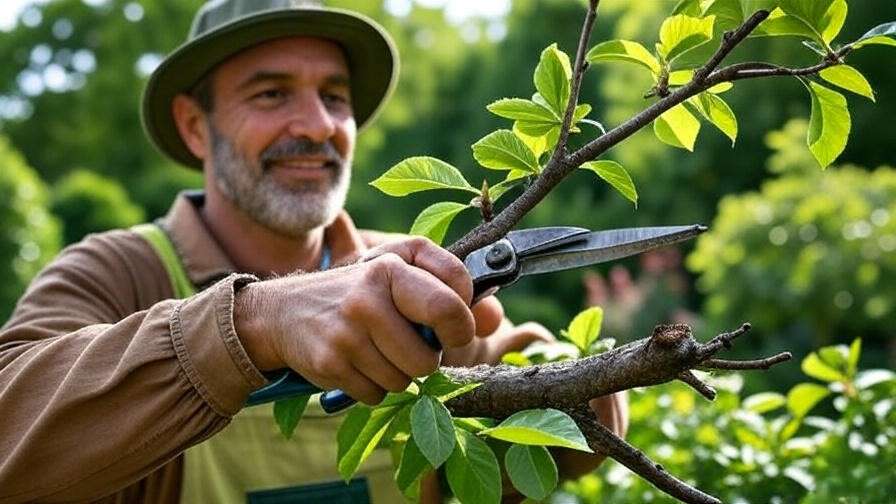
Pro Tip: Keep tools sharp and sanitized with a 10% bleach solution to prevent spreading diseases like bacterial canker.
H3: Preparing Your Cherry Tree and Workspace 🌿
Before pruning, take these steps:
- Sanitize Tools: Dip blades in a bleach-water mix or rubbing alcohol.
- Assess Tree Structure: Study the tree’s shape to plan cuts (e.g., open-center for sweet cherries).
- Clear the Area: Remove debris and ensure a stable ladder setup.
- Check for Hazards: Avoid pruning near power lines or on windy days.
Safety Note: Wear gloves to protect against sharp branches and ensure ladders are secure to prevent falls.
H2: Step-by-Step Guide to Pruning Cherry Trees 🌳
H3: Step 1: Remove Dead, Damaged, or Diseased Wood 🪓
Start by tackling the “three Ds”: dead, damaged, or diseased wood. These branches drain energy and harbor pests or pathogens. Use shears or a saw to remove:
- Dead branches (dry, brittle, no buds).
- Damaged branches (cracked or storm-broken).
- Diseased branches (showing gummy sap, black spots, or wilting).
How to Identify: Scratch the bark—if it’s brown and dry underneath, it’s dead. Cut back to healthy wood, about ¼ inch above a bud or branch collar.
Visual Idea: Include an infographic showing how to spot and remove dead wood.
H3: Step 2: Thin Out Crowded Areas for Better Airflow 💨
Crowded branches reduce sunlight and air circulation, leading to smaller fruit and higher disease risk. Thin the canopy by:
- Removing inward-growing branches.
- Cutting branches that cross or rub.
- Spacing branches to allow 6-12 inches of airflow.
Example: A gardener in Oregon noticed her cherries were small and tart. After thinning 20% of her tree’s interior branches, she saw larger, sweeter fruit the next season.
Why it Works: Thinning improves light exposure, boosting photosynthesis and fruit quality.
H3: Step 3: Shape the Tree for Structure and Aesthetics 🎨
Shaping your cherry tree ensures a strong structure and a visually appealing form. Most cherry trees thrive with an open-center (vase-shaped) structure for sweet varieties or a modified central leader for sour varieties. Here’s how to shape your tree:
- Open-Center Shape: Remove the central leader to create a bowl-like canopy, ideal for sunlight penetration and fruit accessibility.
- Modified Central Leader: Maintain a central trunk with evenly spaced lateral branches for compact sour cherry trees.
- Select 3-5 strong scaffold branches (main limbs) and remove competing or weak ones.
- Trim to maintain balance, ensuring no single branch dominates.
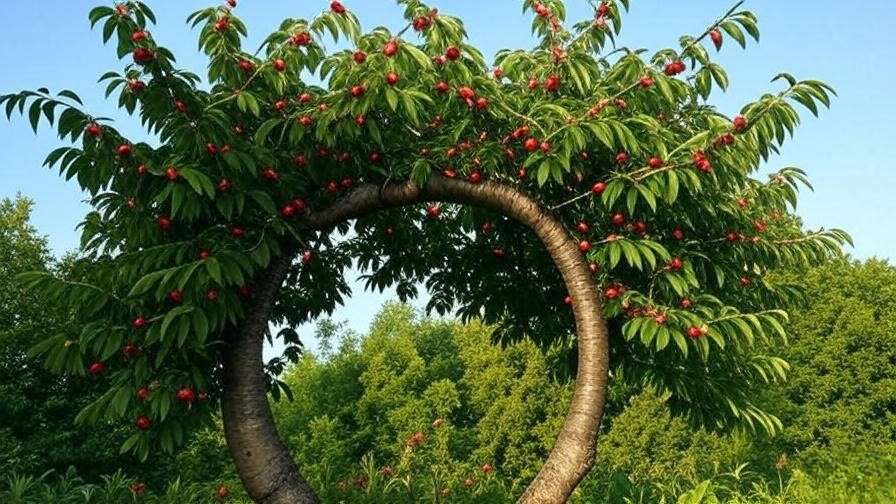
Case Study: A Michigan homeowner reshaped her neglected sweet cherry tree to an open-center form over two seasons. The result? Easier harvesting and a 30% increase in fruit size.
Pro Tip: Aim for a balanced silhouette where branches are evenly spaced, like spokes on a wheel, to enhance both aesthetics and productivity.
H3: Step 4: Prune for Fruit Production 🍒
To maximize cherry yields, focus on encouraging fruiting spurs—short, stubby branches where cherries form. Follow these steps:
- Preserve Fruiting Spurs: Identify spurs (1-3 inches long, often with multiple buds) and avoid cutting them.
- Remove Water Sprouts and Suckers: These vigorous, upright shoots steal energy from fruit production. Cut them at the base.
- Balance Growth: Prune back overly long branches to redirect energy to fruiting wood.
Expert Insight: For sweet cherries, aim to retain 60-70% fruiting wood; for sour cherries, 50-60% is ideal. Over-pruning can reduce yields, so be conservative.
Pruning Schedule:
- Year 1: Establish shape and remove problem branches.
- Years 2-3: Focus on thinning and spur development.
- Mature Trees: Maintain structure with light annual pruning.
H3: Step 5: Make Clean Cuts and Avoid Common Mistakes ✂️
Proper cutting techniques prevent damage and promote healing. Follow these guidelines:
- Cut at a 45-Degree Angle: Make cuts just above a bud or branch collar to encourage growth and prevent water pooling.
- Use the Right Tool: Match the tool to the branch size (shears for small, saw for large).
- Avoid Tearing: Ensure clean cuts to minimize stress and disease risk.
Common Mistakes to Avoid:
| Mistake | Impact | Fix |
|---|---|---|
| Over-pruning | Reduced fruit yield, tree stress | Remove no more than 20-25% of canopy |
| Leaving stubs | Invites rot and pests | Cut close to the branch collar |
| Cutting too close to trunk | Slow healing, disease entry | Leave a small collar intact |
| Pruning in wet weather | Spreads fungal infections | Prune on dry, sunny days |
Troubleshooting Tip: If you accidentally over-prune, focus on aftercare (watering, fertilizing) to help the tree recover.
H2: Aftercare: Supporting Your Cherry Tree Post-Pruning 🌱
H3: Fertilizing and Watering After Pruning 💧
Pruning stresses cherry trees, so proper aftercare is crucial for recovery:
- Fertilizing: Apply a balanced fertilizer (e.g., 10-10-10 NPK) in early spring to support new growth. Use about 1 pound per year of tree age, spread evenly around the drip line.
- Watering: Provide deep, consistent watering (1-2 inches per week) to help the tree heal and establish new growth.
- Mulching: Add a 2-4 inch layer of organic mulch (e.g., wood chips or compost) around the base, keeping it 6 inches from the trunk to prevent rot.
Expert Tip: Compost or aged manure applied post-pruning boosts soil nutrients and aids recovery.
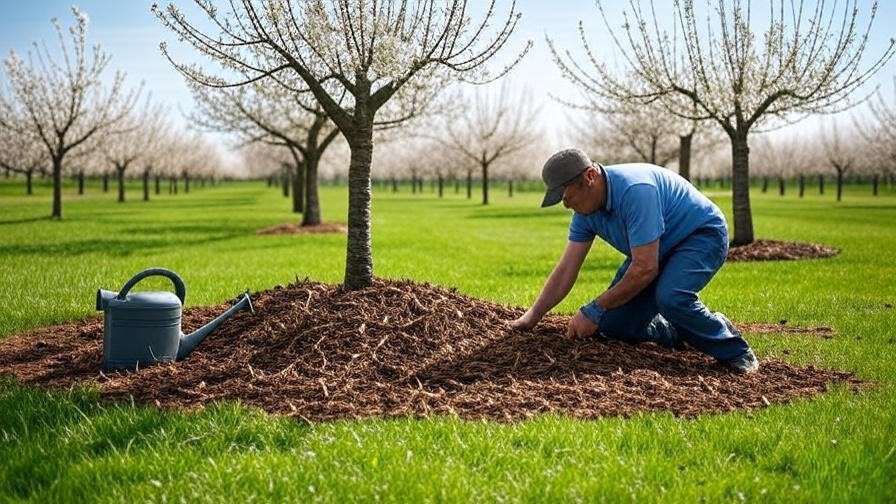
H3: Monitoring for Stress or Disease 🩺
After pruning, keep an eye on your tree for signs of stress or disease:
- Stress Indicators: Wilting leaves, slow bud development, or stunted growth suggest the tree needs extra care.
- Disease Signs: Look for gummy sap (bacterial canker), black spots (cherry leaf spot), or powdery mildew on leaves.
- Preventive Measures: Apply a copper-based fungicide after pruning if your area is prone to fungal issues. Monitor for pests like aphids or cherry fruit flies.
Seasonal Care Calendar:
- Spring: Prune, fertilize, and water deeply.
- Summer: Monitor for pests and light prune if needed.
- Fall: Clear fallen leaves to prevent disease.
- Winter: Inspect for damage and plan next pruning.
H2: Advanced Pruning Techniques for Mature Cherry Trees 🌳
H3: Rejuvenating Older Cherry Trees 🌿
Neglected or overgrown cherry trees can still be revived with rejuvenation pruning:
- Assess the Tree: Identify weak, unproductive branches and dense areas.
- Gradual Approach: Spread heavy pruning over 2-3 years to avoid shocking the tree. Remove 20-30% of old wood each year.
- Focus on Renewal: Cut back to healthy lateral branches to stimulate new growth and fruiting spurs.
Case Study: A Washington orchardist rejuvenated a 20-year-old cherry tree by removing one-third of its canopy over three seasons. By year four, the tree produced 50 pounds of cherries, up from just 10 pounds.
Pro Tip: Be patient—rejuvenation takes time but can extend a tree’s productive life by decades.
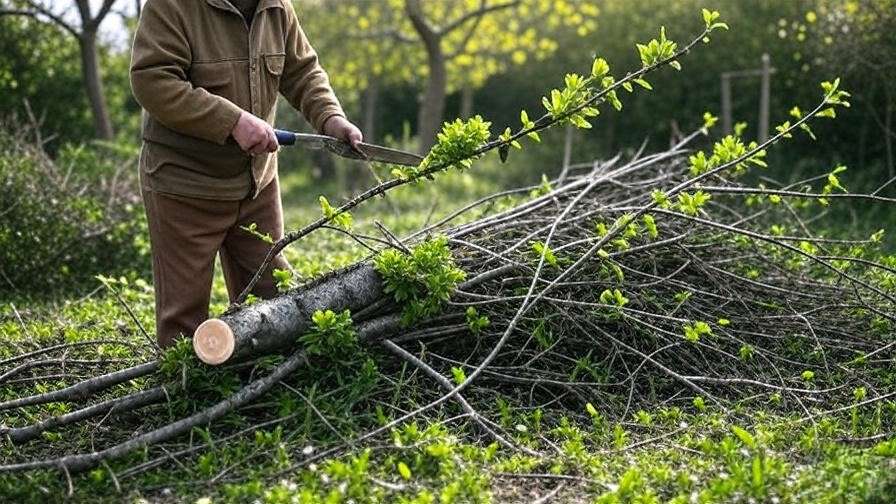
H3: Training Young Cherry Trees for Long-Term Success 🌱
Young cherry trees (1-3 years old) need careful pruning to establish a strong framework:
- Year 1: Select 3-5 scaffold branches and remove the rest. Cut the central leader for open-center shapes.
- Year 2: Thin new growth to maintain spacing and encourage fruiting spurs.
- Year 3: Refine the shape and remove suckers or water sprouts.
Timeline for Young Trees:
- Year 1: Establish structure (open-center or central leader).
- Year 2-3: Promote fruiting wood and balance growth.
- Year 4+: Transition to maintenance pruning.
Expert Insight: Training young trees properly can double their productive lifespan and yield.
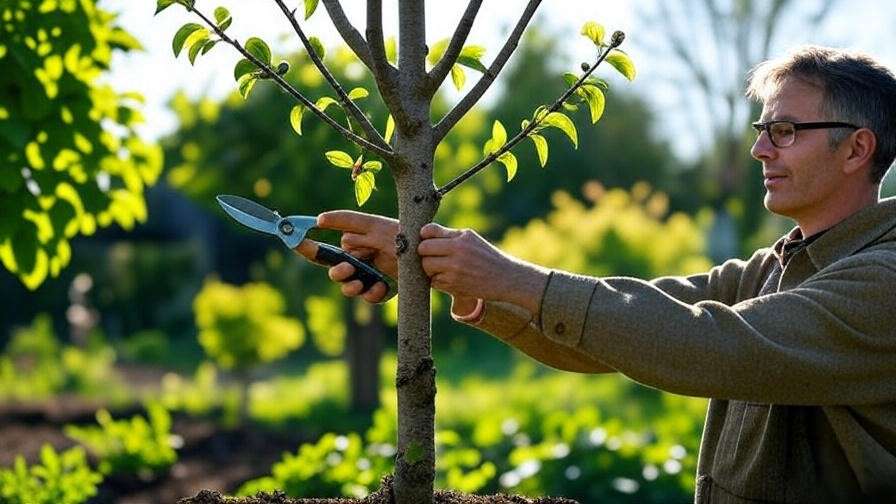
H2: Common Cherry Tree Pruning FAQs ❓
- Can I prune my cherry tree in summer?
Light pruning for shaping or removing water sprouts is fine in summer, but avoid heavy cuts to prevent stress. - How much should I prune each year?
Remove no more than 20-25% of the canopy to avoid shocking the tree. - Does pruning reduce fruit production?
When done correctly, pruning boosts fruit quality and yield by focusing energy on fruiting spurs. - What if I accidentally over-prune?
Provide extra water and fertilizer, and avoid further pruning for a season to allow recovery. - How do I prune ornamental cherry trees?
Focus on shaping for aesthetics and removing dead wood, with minimal cuts to preserve blooms. - Can pruning prevent cherry tree diseases?
Yes, by improving airflow and removing diseased branches, pruning reduces risks like bacterial canker. - Do dwarf cherry trees need different pruning?
Dwarf trees require more precise cuts to maintain their compact shape and maximize fruit in limited space.
H2: Conclusion: Prune Your Way to Thriving Cherry Trees 🌸
Pruning cherry trees is more than a chore—it’s an investment in healthier trees, juicier cherries, and a stunning garden. By following this guide, you’ll master the art of pruning, from timing and tools to advanced techniques for mature trees. Whether you’re a novice gardener or a seasoned orchardist, these expert-backed steps will ensure your cherry trees thrive for years. Start pruning with confidence today, and share your success stories in the comments below! For more tree care tips, explore our guides on cherry tree diseases and fertilizing fruit trees. Happy pruning! 🍒

